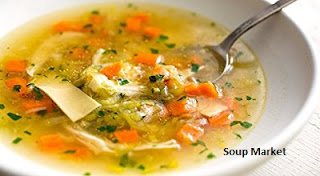Global soup market is expected to witness a steady growth owing to its presence in daily diet especially in South East Asia. Soup consumption by people under medical observation is expected to trigger the market growth in near future. A soup is a liquid food mostly consisting of vegetables and meat. It is usually served warm before any meals and is a very popular appetizer. Most forms of soup are taken before a meal to stimulate the appetite. The existence of soup can be traced far back, however its commercialization started in the 19th century with the invention on canning. These items are catered to the consumers with a lot of variety depending on the local taste. Development of retail sector has been driving the market in recent years. These products are available at retail stores either in cans or in dried form. Canned products need warming before consumption whereas the dried ingredients are to be mixed with boiled water. Development of packaging industry has helped in driving the growth of these eatery items.
Sophisticated packaging solutions
have resulted in increasing shelf life and therefore preserving the taste and
nutrient. Small eatery vendors and café outlets have been serving soups on
account of their increasing popularity. These outlets form an integral part of
the value chain of street food where consumers buy products on account of its
affordable cost and convenience. Companies are targeting these small vendors in
order to increase their presence in the retail market and connect with the end
consumers. These small eatery outlets are used by smart marketers to promote
their products using attractive sign boards. The Campbell soup company
invented condensed soup in 1897 and revolutionized the commercial soup market
in the U.S. Condensed soup are canned products in the concentrated form which
need the addition of water. Condensation allowed manufacturers to pack these
products in smaller cans and sell at a lower price. Moreover, consumers were
able to customize their soups using this condensed liquid as a base for
home-made soups.
Hectic lifestyle and increasing
standard of living drive the consumption of ready to eat products in urban
areas. Commercial soups available in the retail stores are quick and easy to
make. Canned and dried packs are available in supermarkets, hypermarkets and
convenience stores. Canned products are marketed as ready to eat with no
further requirement for further processing. The demand has further increased
owing to microwave bowls, offering convenience at workplaces and small café
outlets. Clear soups are known to contain vegetables with less salt. Their
increasing popularity as a diet for medical patients is expected to drive the
demand in near future. Health aware consumers prefer clear soups on account of
its nutrient content and low salt content. Such market trend is expected to
propel the demand over the forecast period.
Some ingredients used in the
manufacturing are subjected to health concerns, which are expected to pull the
demand down in the near future. Some soup categories are not preferred by the
consumers owing to the presence of monosodium glutamate. Companies have come up
with products without monosodium glutamate in order to cater these consumers.
Some consumers may show symptoms of allergy due to the presence of corn, soy,
and nuts. Automated manufacturing of these products offers bright
opportunities for the overall industry growth. Production with the help of
machines reduces the risk of contamination on account of human touch. Also,
manufacturers are able to produce on a larger scale and therefore optimize
their cost. These products vary from region to region and depend on local
taste. Manufacturers tend to modify their products in order to satisfy the need
of local consumers.
Get Sample Copy of
Soup Market at : https://www.millioninsights.com/industry-reports/soup-market/request-sample
The market is broadly segmented
based on product type, which includes thick soup and clear soup. Further, they
are classified based on the product delivery for end consumer, which includes
canned packaging and dried packaging. Canned products are high in demand in
North America whereas the Asian market is mostly filled with dried packaged
items. Asia Pacific dominated the regional demand and is expected to
continue the trend in near future as soups are an integral part of daily diet
especially in South East Asia. Regional demand is followed by North America.
The U.S market witnesses the significant sale of these ready to eat food items
owing to its convenience. Key players operating in the manufacturing of
commercial soup are Maggi, Unilever, Campbell, Associated British Foods, Heinz,
Premier foods and Hain holdings. The Southeast Asian market is unstructured
compared to North America on account of the presence of small players catering
to local tastes.



No comments:
Post a Comment